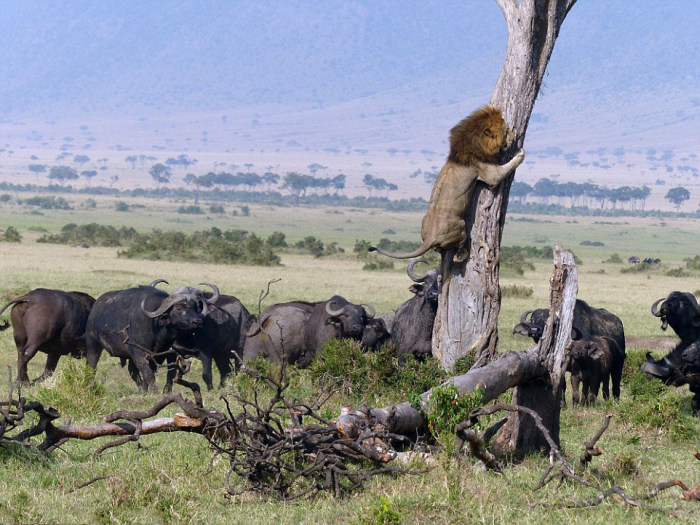|
|
Lion Climbs Tree To Escape A Buffalo Herd
|
The average gestation period is around 110 days, the female giving birth to a litter of one to four cubs in a secluded den (which may be a thicket, a reed-bed, a cave or some other sheltered area) usually away from the rest of the pride. She will often hunt by herself whilst the cubs are still helpless, staying relatively close to the thicket or den where the cubs are kept. The cubs themselves are born blind—their eyes do not open until roughly a week after birth. They weigh 1.2–2.1 kg (2.6–4.6 lb) at birth and are almost helpless, beginning to crawl a day or two after birth and walking around three weeks of age. The lioness moves her cubs to a new den site several times a month, carrying them one by one by the nape of the neck, to prevent scent from building up at a single den site and thus avoiding the attention of predators that may harm the cubs.
Usually, the mother does not integrate herself and her cubs back into the pride until the cubs are six to eight weeks old. However, sometimes this introduction to pride life occurs earlier, particularly if other lionesses have given birth at about the same time. For instance, lionesses in a pride often synchronize their reproductive cycles so that they cooperate in the raising and suckling of the young (once the cubs are past the initial stage of isolation with their mother), who suckle indiscriminately from any or all of the nursing females in the pride. In addition to greater protection, the synchronization of births also has an advantage in that the cubs end up being roughly the same size, and thus have an equal chance of survival. If one lioness gives birth to a litter of cubs a couple of months after another lioness, for instance, then the younger cubs, being much smaller than their older brethren, are usually dominated by larger cubs at mealtimes—consequently, death by starvation is more common amongst the younger cubs.
In addition to starvation, cubs also face many other dangers, such as predation by jackals, hyenas, leopards, martial eagles and snakes. Even buffaloes, should they catch the scent of lion cubs, often stampede towards the thicket or den where they are being kept, doing their best to trample the cubs to death whilst warding off the lioness. Furthermore, when one or more new males oust the previous male(s) associated with a pride, the conqueror(s) often kill any existing young cubs, perhaps because females do not become fertile and receptive until their cubs mature or die. All in all, as many as 80 percent of the cubs will die before the age of two.
When first introduced to the rest of the pride, the cubs initially lack confidence when confronted with adult lions other than their mother. However, they soon begin to immerse themselves in the pride life, playing amongst themselves or attempting to initiate play with the adults. Lionesses with cubs of their own are more likely to be tolerant of another lioness's cubs than lionesses without cubs. The tolerance of the male lions towards the cubs varies—sometimes, a male will patiently let the cubs play with his tail or his mane, whereas another may snarl and bat the cubs away.
|
|









